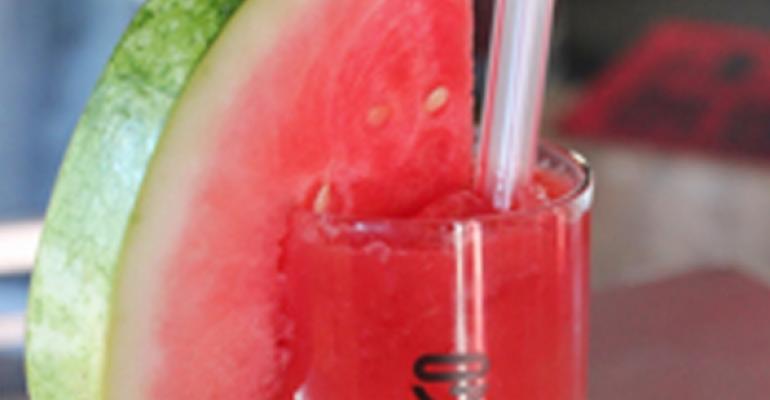RELATED
• Pizza Ranch adopts coffee program to support Ethiopian charity
• Restaurant keeps some cocktails secret
• More food and beverage news
Renewed and intensified interest in beverages represents a big growth opportunity for restaurants, industry research firms have found, and many chains are eager to cater to this new demand.
While NPD recently found that beverage-only traffic rose for the 12 months ended this past June, Technomic also recently reported that specialty drinks, both alcoholic and nonalcoholic, held much of the potential for further growth.
According to Technomic’s “Beverage Consumer Trend Report,” 71 percent of consumers now purchase beverages away from home twice a week or more often, an increase from 66 percent in 2010.
Brewing something new
Technomic also found that new and inventive beverages could be a major draw for customers, especially those among the younger demographic. Forty-seven percent of consumers between the ages of 18 and 24 reported that they would like to try new and unique beverages offered at restaurants, compared with only 29 percent of overall consumers.
 A drink menu full of signatures has helped seven-unit Hash House A Go Go attract more traffic since its inception in 2000, co-owner Jim Rees recently told Nation’s Restaurant News. Many of those beverage-only visits come at traditionally off-peak times, helping the restaurant stay busy all day, he said.
A drink menu full of signatures has helped seven-unit Hash House A Go Go attract more traffic since its inception in 2000, co-owner Jim Rees recently told Nation’s Restaurant News. Many of those beverage-only visits come at traditionally off-peak times, helping the restaurant stay busy all day, he said.
“One of our busiest times of the day is between 9:30 and noon, when most restaurants have nobody in them,” he said.
Hash House A Go Go sells many specialty drinks like Kiwi Watermelon Lemonade, the Banana Latte, and a S’mores Mocha, all of which are meant to appeal to guests’ sense of sight as much as their sense of taste, Rees said.
Technomic analyzed menu data from the brands contained within its Top 500 limited-service restaurant list and found that development of such specialty coffee, tea and smoothies experienced robust growth over the past several years.
Offerings for specialty coffee rose 10 percent from 2010 to 2012, while instances of smoothies on chain menus grew by 8.5 percent. Listing for tea, especially sweet tea, nearly doubled on menus during that period, while the largest proliferation came from protein-enhanced smoothies, which grew 123 percent from 2010 to 2012, Technomic found.
“Today’s foodservice consumers continue to base dining decisions on their perception of value,” Technomic executive vice president Darren Tristano said in a statement. “Innovative operators are creating value by crafting new and unique beverages, including specialty lemonades, handmade sodas and ‘mocktails’ that are uniquely flavorful, fresh and better-for-you options.”
Red Mango has combined coffee and smoothies in one of its newest drink offerings, Frozen Coffee Chillers. The lineup comes in four flavors: vanilla, caramel, mocha and natural coffee.
Smoothies are a popular platform for drink innovation, whether they include the new raspberry real-fruit smoothie at Burger King, or the Orange Julius-branded smoothies that Dairy Queen will roll out to enter the quick-service specialty beverage fray.
 Seasonality presents another opportunity, as seen in Dunkin’ Donuts’ reprisal of pumpkin-flavored drinks for fall. The chain will sell not only the Pumpkin Coffee and Pumpkin Latte, but also pumpkin-flavored K-Cup single-serve drinks in retail stores.
Seasonality presents another opportunity, as seen in Dunkin’ Donuts’ reprisal of pumpkin-flavored drinks for fall. The chain will sell not only the Pumpkin Coffee and Pumpkin Latte, but also pumpkin-flavored K-Cup single-serve drinks in retail stores.
Changing opportunities in beer sales
In a separate report, the “2012 BeerTAB (Trends in Adult Beverage),” Technomic found that other opportunities for beverage sales at restaurants would be craft beer, cider and flavored malt beverages, as consumer trends for beer drinkers have become less favorable for traditional high-volume brands of domestic beer.
Beer sales declined 1.3 percent in 2011 to 2.8 billion 2.25-gallon cases, Technomic found, driven in large part by declines of 2.6 percent for domestic light-beer volume and 3.2 percent for domestic regular-beer volume.
“The core consumers for the major domestic brands were among those most impacted by the recession, so their spending habits changed,” said Donna Hood Crecca, senior director of Technomic’s Adult Beverage Resource Group. “At the same time, taste preferences evolved, especially among younger consumers, and we saw beer drinkers increasingly seeking different styles and more complex or varied flavor profiles. Both trends affected the powerhouse categories and brands, which resulted in the overall decline.”
By contrast, volume for craft beer grew 11.2 percent in 2011, Technomic found, while volume for cider rose 31.3 percent. Thanks to seasonal flavors and new-brand introductions, volume for flavored malt beverages rose 3.3 percent in 2011, the report said.
Red Robin’s new beverage lineup leverages the industry’s move toward specialty alcohol, as well as seasonality. The chain launched a spiked Oktoberfest Milkshake and the Honey Bourbon Lemonade to celebrate Oktoberfest. The milk shake combines ice cream, Samuel Adams Octoberfest draft, vanilla and caramel. The lemonade drink incorporates bourbon and agave nectar, and then is shaken and served with mint.
Contact Mark Brandau at [email protected].
Follow him on Twitter: @Mark_from_NRN

